Articles
“One of the best advertising mediums the country can have:”
Postage Stamps and National Identity in Canada, New Zealand and Australia
Abstract
This article examines the transformation of postage stamp imagery in Canada, New Zealand and Australia from the late 19th century to the 1990s. It documents the manner in which this imagery evolved from a predominately ethnic representation during the first half of the 20th century to a preponderance of civic–nationalistic designs in the post-1960s period. By highlighting the largely similar ways in which the governments of these three nations used postage stamps to guide and reflect the revision of their respective national identities, the article seeks to encourage greater comparative work among scholars examining the political and cultural histories of these nations. It also emphasizes the utility of recognizing postage stamps as rich primary sources of material culture that can facilitate comparative research that focuses on broad temporal and geographic parameters.
Résumé
Cet article examine la transformation de l’imagerie des timbres-poste au Canada, en Nouvelle-Zélande et en Australie de la fin du XIXe siècle jusqu’aux années 1990. Il documente la façon dont cette imagerie a évolué, passant d’une représentation principalement ethnique au cours de la première moitié du XXe siècle à une prépondérance de dessins de style civique et nationaliste après les années 1960. En mettant en relief les façons semblables, mais parfois différentes, dont les gouvernements de ces trois nations ont utilisé les timbres-poste pour former et pour refléter la révision de leurs identités nationales respectives, l’article cherche à encourager un traitement comparatif de l’histoire politique et culturelle de ces nations chez les scientifiques examinant ces questions. Il souligne aussi l’utilité de reconnaître les timbres-poste comme de riches sources primaires de la culture matérielle susceptibles de faciliter la recherche comparative qui fait porter le regard sur de plus larges paramètres temporels et géographiques.
1 In January 1911 Australia’s Labour government invited British subjects to submit designs for the country’s first stamps. The winning design was a full-face portrait of King George V complete with six shields bearing the insignia of each state, a kangaroo and an emu. However, October of that year saw the arrival of a new Postmaster General, Charles Frazer. Frazer quickly discarded the winning entry, describing it to Parliament as “execrable,” and commissioned a new stamp design (Lawrie 2011). The new image, approved by Frazer, and commonly referred to as the “kangaroo-and-map” stamp, was released in January 1913 (Fig. 1). Featuring a black kangaroo within a white silhouette of the Australian Commonwealth, Frazer triumphantly described the stamp as a kangaroo “rampant [sic] upon a purely White Australia” in recognition of Australia’s restrictive immigration policy (McMullin 1981; Altman 1991: 57). Yet six months later the Liberals toppled the Labour government, and the country’s new Postmaster General, Agar Wynne, announced that Frazer’s choice was to be replaced by the 1911 competition-winning stamp image. Frazer, now in opposition, defended his choice. “A postage stamp is one of the best advertising mediums the country can have,” he argued, insisting that an Australian stamp with a British monarch on it did not represent Australia. George V won the day on this occasion but the kangaroo-and-map stamps continued to be issued until 1948—a development that underscores the political nature of Australia’s stamp production (Lawrie 2011).
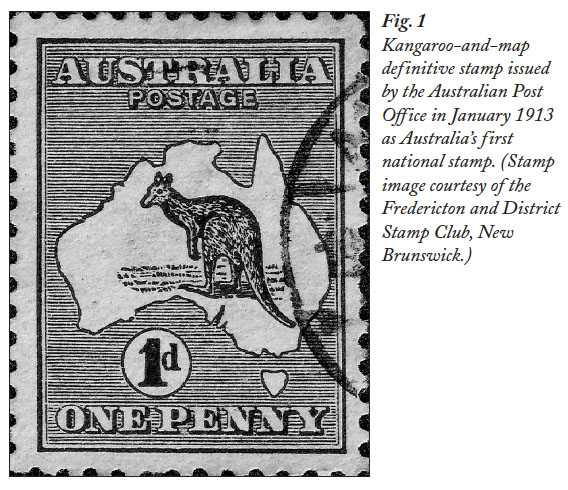 Display large image of Figure 1
Display large image of Figure 12 This tension between national and imperial themes reflected a burgeoning “colonial nationalism” not only in Australia but also in the British Empire’s other “white dominions” (Eddy and Schreuder 1988; Buckner and Francis 2005, 2006; Darian-Smith, Grimshaw and Macintyre 2007). Canada, Australia and New Zealand all endured awkward transformations from British settler societies to independent nations. Indeed, a growing body of work demonstrates that national identity in all three countries underwent significant reinterpretation during the 1960s (Igartua 2006: 5; Curran and Ward 2010: 5; Bell 1996). Moreover, such scholarship recognizes that beginning in the 1960s, the national government in each of these dominions undertook initiatives to facilitate the redefinition of a national identity that would embrace a civic, rather than ethnic, nationalism. Cultural symbols, including flags, anthems and television content were common reference points as these governments grappled with colonial legacies and changing economic and political realities. And yet while scholars of all three nations have identified this pattern, very little in the way of comparative work explores just how similar or different such initiatives were.
3 Postage stamps offer one promising avenue for such exploration. As Charles Frazer’s less-than-subtle observation above suggests, government-issued stamps were imbued with an expectation that they represent the nation to its inhabitants and the rest of the world. Moreover, as human-made objects that “reflect ... the beliefs of the individuals who commissioned, fabricated, purchased or used them and by extension the beliefs of the larger society to which these individuals belonged” (Prown 1993: 1), stamps are a valuable source of material culture. These small colourful pieces of paper, seen by citizens on an almost daily basis up until the late-20th-century explosion of electronic communications, are components of the print media, consequently making them potential instruments in the development of an “imagined community” (Anderson 1983: 47-49). Moreover, as historian Robert Jones points out, postage stamps are official products of governments keen to promote selected images domestically and internationally. They are thus useful, if often overlooked, resources for those interested in studying the construction of national identities (2001: 403).
4 Jones is not alone in championing the scholarly value of stamps. Indeed, Douglas Frewer argues that postage stamps are a significant component of material culture that can be used by a state to define a national identity for itself and shape how it is viewed by the rest of the world (2002: 1-2) while Paul Van der Grijp describes stamps as multidimensional semiological tools capable of bringing disparate parts of a nation or empire together (2004: 87; 2012: 42). For Pauliina Raento and Stanley Brunn, postage stamps are part of the daily flagging of national identity carried out by governments, a process Michael Billig defines as “banal nationalism” (Raento and Brunn 2005: 145; Billig 1995: 6). This process ensures that citizens’ sense of nationalism becomes endemic—ready to be called upon at times of national threat or crisis. In linking postal imagery with banal nationalism, Raento and Brunn afford stamps an influence equivalent to more commonly studied national symbols such as state flags, currency, anthems, museums and sporting events. Others support their claims with case studies of Japan, the Middle East and France (Frewer 2002; Reid 1984; Scott 2002).
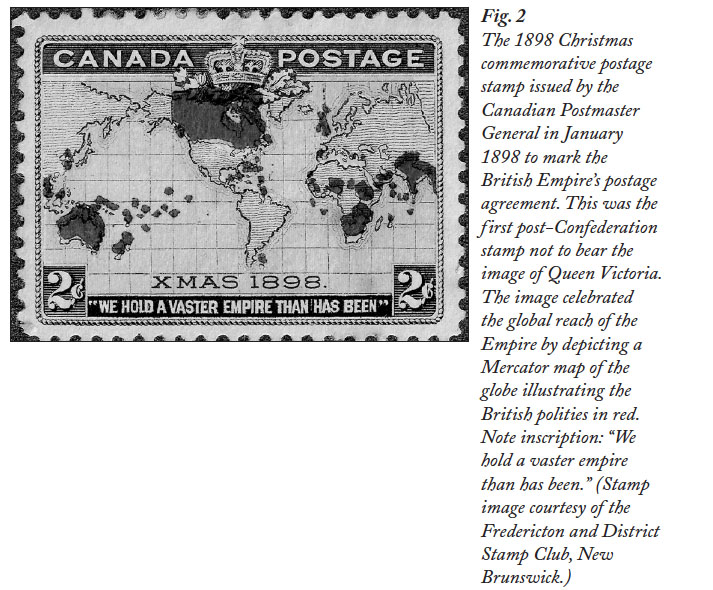 Display large image of Figure 2
Display large image of Figure 25 In the pages that follow, I trace the development of postage stamp imagery in Canada, New Zealand and Australia throughout the 20th century. I proceed first on a case-by-case basis and conclude by drawing comparisons between the three nations. I focus directly on the manner in which each nation publicly demonstrated its declining links to the British Empire. In doing so I note that the images found on postage stamps in all three countries evolved from a predominately ethnic focus during the first half of the 20th century to portray a preponderance of civic images post 1960. I pay particular attention to when and how indigenous peoples and women first appeared on the stamps as icons of national identity as well as to the manner in which significant historical events were depicted.
6 Over the course of my research I examined more than 7000 postage stamps. In reviewing this array of definitive and commemorative postage stamps, I identified 1770 Canadian, 1815 New Zealand and 2204 Australian distinctive stamp images.1 “Definitives” are issued for regular postal use for unspecified periods of time, whereas “commemoratives” are issued for a specific period of time, usually less than a year, to commemorate a person, achievement, event or anniversary. Examination of this body of stamps clearly demonstrates that postal imagery in all three dominions transitioned during the 20th century from emphasizing British cultural components to designs that, although not totally devoid of Anglo-Saxon refrains, were predominated by civic symbols, complemented by exhibitions of autonomous global involvement. While all three nations followed this general pattern, there were important differences in how this transition was managed—particularly concerning the timing and prevalence of the incorporation of women and indigenous peoples into the pantheon of acceptable national imagery.
Canada
7 Early Canadian stamps displayed a strong connection to the British Empire while simultaneously championing a bi-cultural French–English characterization of Canada. The Dominion of Canada issued its first postage stamps in April 1868, a seven-stamp definitive series all bearing the image of Queen Victoria as the central motif, a pattern that continued uninterrupted until 1898. In 1898 the Canadian Postmaster General broke with tradition and issued the first non-monarchial postage stamp. The stamp depicted a Mercator’s map of the globe illustrating the British Empire polities in red and proclaimed “We Hold a Vaster Empire Than Has Been” (Fig. 2; Patrick and Patrick 1964: 26-28, 38). Monarchial stamps remained abundant, however, and at times featured timely notations. For example, in 1915-1916 King George V stamps featured the additional wording “War Tax” or “1T¢” to signify Canada’s financial efforts to support the Great War through the collection of a one cent tax on letters and postcards (Patrick and Patrick 1964: 185-86).
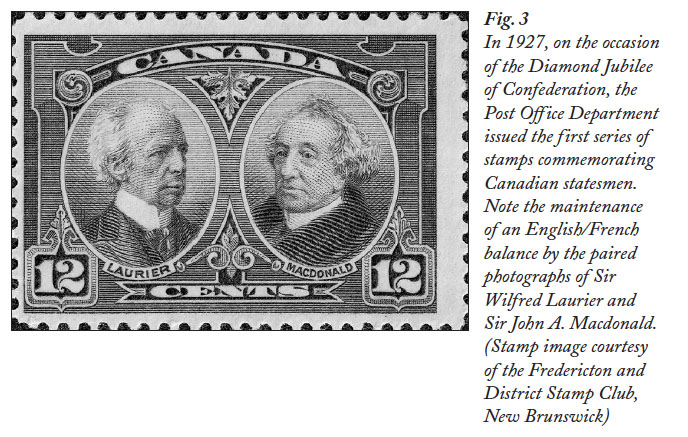 Display large image of Figure 3
Display large image of Figure 38 Non-monarchial commemorative stamps issued during the first five decades of the 20th century were carefully designed to project a balance of French and English images. For example, in 1908, to celebrate the 300th anniversary of the founding of Quebec by Samuel de Champlain, the Post Office Department released an eight-stamp series that, in keeping with the dominant theme of the tercentenary celebrations, blended English and French content. The series included the paired portraits of King Edward VII and Queen Alexandra, the Prince and Princess of Wales as well as military leaders Montcalm and Wolfe and explorers Samuel de Champlain and Jacques Cartier (Patrick and Patrick 1964: 42-45; Nelles 1996: 394). Similarly, when the Diamond Jubilee year 1927 saw the first release of stamps commemorating Canadian statesmen, one stamp depicted paired photographs of Robert Baldwin and Sir Louis-Hippolyte Lafontaine, political reform leaders in Upper and Lower Canada, respectively, while another featured Sir John A. Macdonald, Canada’s first Prime Minister, and Sir Wilfrid Laurier, Canada’s first French-Canadian Prime Minister (Fig. 3; Patrick and Patrick 1964: 51-53). That same year stamps became bilingual, with “postes” and “post” inscribed on opposite margins. This cultural equilibrium was creatively maintained in 1934 when a stamp image of Jacques Cartier landing on Canadian shores commemorating the 400th anniversary of Canada’s European discovery was cleverly balanced by the simultaneous release of a commemorative stamp celebrating the sesquicentennial of the “completion” of the immigration of the United Empire Loyalists to Canada (Patrick and Patrick 1964: 68-69). From the late 19th century through to the 1940s, then, Canada’s stamps paid homage to the British Empire while endeavouring to offer a bicultural balance.
9 In the late 1940s and 1950s, though, an important transition started to take shape. While images of the monarch including the new sovereign, Queen Elizabeth II, remained prominent on definitive and commemorative stamps, representations suggestive of a more civic, international and inclusive Canadian national identity became more apparent. For example, the 80th anniversary of Confederation was marked by a stamp celebrating the 1947 passage of the Canadian Citizenship Act (Fig. 4; Patrick and Patrick 1964: 85). Four years later the government introduced a multiyear series of stamps honouring Canadian-born Prime Ministers while a multiple-year series celebrated Canadian wildlife featuring such distinctive species as the Canada goose, polar bear, moose and beaver (Patrick and Patrick 1964: 96-107). Moreover, Canada was now issuing stamps that highlighted its participation in endeavours beyond the British Empire, including the United Nations’ International Civil Aviation Organization, the North Atlantic Treaty Organization (NATO) and its first joint-issue commemorative with the United States illustrating the opening of the St. Lawrence Seaway (Fig. 5; Patrick and Patrick 1964: 102, 115, 117).
 Display large image of Figure 4
Display large image of Figure 4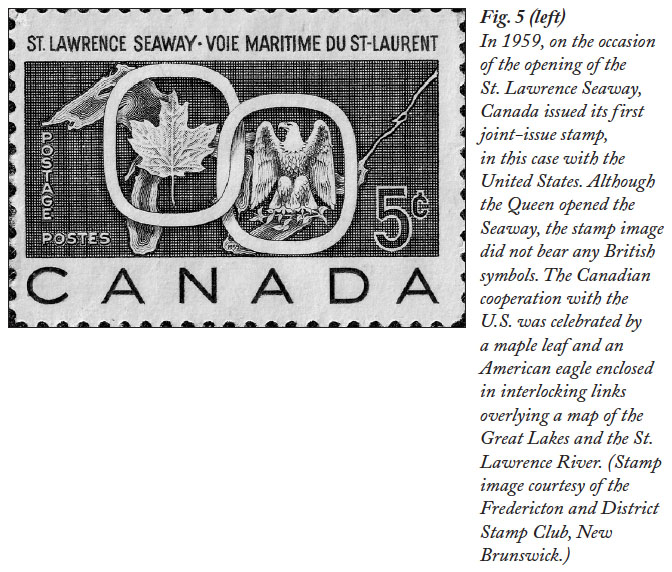 Display large image of Figure 5
Display large image of Figure 510 It was during the 1950s as well that the government began to actively incorporate Aboriginal peoples and women into its stamp imagery. Canadian Aboriginal heritage was first honoured in 1953 and 1955 with individual stamps featuring the totem pole of Canada’s West Coast “Indians” and an “Eskimo” (labelled as such in the press releases) hunter in a kayak respectively (Patrick and Patrick 1964: 96, 101). Stamps dedicated to the contributions of Canadian women were very infrequent until the late 1950s. A 1958 stamp commemorated women’s contributions to the nation’s health by exhibiting the portrait of a female nurse, and rural women were honoured in 1959 with a commemorative stamp that celebrated the Associated Country Women of the World Association, an organization that had grown out of national associations such as the Federated Women’s Institutes of Canada and the Cercles des Fermières du Québec (Patrick and Patrick 1964: 112-16) and thus fit nicely with the desire to highlight common English and French pursuits.
11 The 1960s was characterized by a continuation of monarchial definitive and commemorative stamps complemented by a balanced menu of British- and French-themed postal images that celebrated past Prime Ministers, early Canadian explorers, notable industrialists, as well as Canadian historical anniversaries. More importantly, however, the decade also saw the Post Office Department significantly expand the number of stamps issued with the additional stamps issued focusing primarily on civic themes. In addition to a smaller proportion of monarchial definitives, the presentation of Queen Elizabeth changed as well, as the Queen began sharing the stamp face with civic symbols of the Canadian economy or geographic regions. In a 1962 definitive series, portraits of the monarch, devoid of any crown or regal trappings, were accompanied by miniature images emblematic of the Canadian economy. The 1967 Centennial series of stamps saw the size proportioning reversed, with the monarch’s image reduced to two fifths of the stamp face with the remaining three fifths depicting images symbolizing Canada’s varying regions or cultures (Canada Post Office Department 1962, 1967). Overall, the fate of the monarch’s image demonstrates the decline of British symbolism and thus the rise of civic imagery. Of the stamps produced between 1867 and 1949, 62.4 per cent bore the image of the monarch. This position of dominance eroded quickly. During the 1950s just 12.6 per cent bore the image of the British Sovereign and by the 1960s the Queen appeared on just 2.8 per cent of Canadian stamps.
12 Stamps issued during the 1960s also reflected the rise of French-Canadian nationalism and continuing attempts by the federal government to reconcile the competing concerns of English- and French-speaking Canadians—hence, the 1964 “Maple Leaf United” stamp, a commemorative boasting no French or English symbols but rather simply the bilingual script “united” and “uni” to accentuate the message of linguistic and cultural cooperation (Canada Post Office Department 1964) and a 1965 stamp to honour Canada’s new national flag (Fig. 6) as “the first distinctive Canadian banner in the nation’s history” (Canada Post Office Department 1965).
 Display large image of Figure 6
Display large image of Figure 613 Civic themes and a trend toward inclusivity dominated Canadian stamp images from the 1970s to the 1990s. A 1973 eight-cent definitive of Queen Elizabeth II was issued, not as a stand-alone monarchial stamp, but as one in a new series honouring six former prime ministers pointing out, in the eyes of Post Office Department, that prime ministers were equal in status to the Queen (Canada Post Office Department 1973). In May 1977 the Post Office introduced a new twelve-cent definitive carrying the image of the Parliament Buildings, adding them to the Queen as a symbol of Canadian democracy (Canada Post Office Department 1977). One Canadian stamp expert posited that the inclusion of the Parliament Buildings may have been designed to appease French Canadians who might resent the Queen’s image on first-class postage whereas other Canadians simply saw it as a more general move to reduce the reliance on symbols of the monarchy (Patrick 1977).
14 The trend toward civic symbols continued in the 1980s and 1990s with stamps celebrating “O Canada” becoming Canada’s official national anthem (Canada Post Office Department 1980); the repatriation of the Canadian Constitution (Fig. 7; Canada Post Corporation 1982); the Canadian Charter of Rights and Freedoms (Canada Post Corporation 1987); and the national flag, which replaced the Parliament Buildings as a permanent symbol on domestic definitives in the 1990s. Recognition of Canadian art and culture was accomplished by a series of stamps that illustrated the landscape paintings of the Canadian group of seven as well as female painters such as Emily Carr (Canada Post Office Department 1970, 1971).
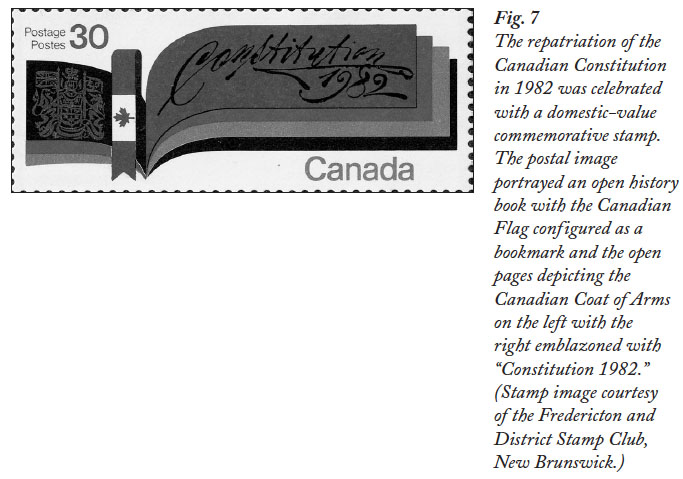 Display large image of Figure 7
Display large image of Figure 715 This period also witnessed the consolidation of the government’s more inclusive approach to stamp symbolism. Whereas stamps had previously commemorated the arrival of settler groups from the British Empire and European nations, they now celebrated Canada’s multi-ethnic identity as embodied in the Multiculturalism Act of 1988 and the contributions of minority groups such as the Ukrainians (Canada Post Corporation 1990, 1991). In 1972, the introduction of a multiyear stamp series entitled “Indians of Canada” saw two stamps issued annually for the next six years that celebrated the culture of First Nations peoples and the Inuit (Canada Post Office Department 1972). Moreover, two series of stamps in the 1980s focused on the accomplishments of women. A 1980 series entitled “Feminists” celebrated women who worked for societal reforms as well as women’s political rights including Dr. Emily Stowe and Idola Saint-Jean while a 1985 series, entitled “Decade for Women,” honoured, among others, Thérèse Casgrain and Emily Murphy (Canada Post Office Department 1981; Canada Post Corporation 1985).
16 The last decade of the century saw the Canadian Flag become one of the most prominent images on domestic stamps. Other stamps of this period reminded Canadians of the significant role that Aboriginals and women had played in Canada’s development, while recognizing the multicultural nature of the nation’s society based on equality for all, as defined in a Canadian Charter of Rights and Freedom. The civic nature of Canada’s late-20th-century national identity was emphasized through postal images that celebrated Canada’s achievement of full independence from Britain while recognizing the Canadian Maple Leaf Flag as Canada’s most important national symbol.
New Zealand
17 Like Canadian stamp images, New Zealand’s postal imagery underwent a progression of emphases, between 1855 and 1999, which reflected a transitioning national identity. Nineteenth-century New Zealand postage stamps were characterized by only two themes: the monarch and scenic pictorials. Queen Victoria was the only image on New Zealand postage stamps between 1855 and 1898 (New Zealand Post 1855-1899). In 1898 New Zealand issued its first pictorial series of stamps featuring Mount Cook and Lake Taupo, New Zealand’s highest peak and largest lake respectively, the kiwi bird, unique to New Zealand, and Māori culture, in the form of the waka, the Aboriginal canoe (New Zealand Post 1898; Walrond 2013). As Claudia Bell points out, the earliest image of New Zealand fostered by Pakeha settlers was of a place of spectacular, untouched natural beauty filled with abundant unique flora and fauna. This Arcadian myth profoundly shaped the nation’s early stamp imagery (Bell 1996: 28-39; Smith 2012: 286).
18 Still, the connection to Britain remained a prevalent theme during the first half of the 20th century. Indeed, between 1855 and 1956, 42.7 per cent of New Zealand’s new stamps bore the image of the monarch. Through to 1953 definitives were revised each time a new monarch assumed the British throne, and commemoratives were issued to celebrate royal anniversaries, coronations and visits. But support for the British Empire was represented in other ways as well, including a 1900 stamp marking the creation of New Zealand’s first Expeditionary Force sent to aid British efforts in the South African War (Fig. 8; New Zealand Post 1900). The following year New Zealand introduced the Penny Universal, a stamp that covered the cost of mailing a letter to Britain, featuring the allegorical Zealandia, understood to be the daughter of Britannia, to represent New Zealand, thereby reinforcing the link to the British Empire (New Zealand Post 1901). Zealandia continued to represent New Zealand on penny-postage for close to a quarter of a century.
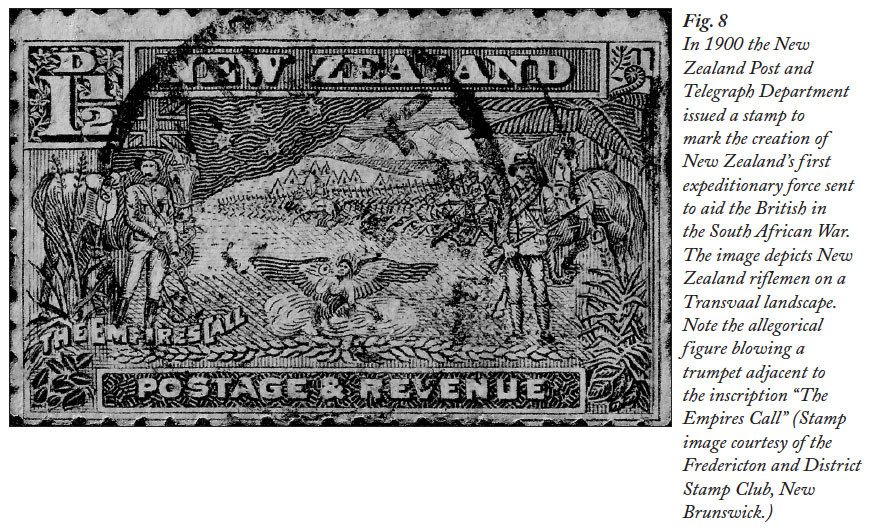 Display large image of Figure 8
Display large image of Figure 819 New Zealanders’ military commitment to the Empire, their linguistic and cultural connections to Britain, continued to be clearly evident in the second quarter of the 20th century. A 1936 stamp depicted a New Zealand Army Corps soldier standing on the beach at Anzac Cove in remembrance of New Zealand’s fallen soldiers at Gallipoli during the First World War (New Zealand Post 1936). Ten years later the government issued a commemorative series addressing the theme of victory and peace. In addition to celebrating New Zealand’s armed forces’ contributions in the Great War, it paid tribute to the tenacity of the Royal Family and the people of Britain during the Second World War (New Zealand Post 1946). New Zealand celebrated the coronation of Queen Elizabeth II in 1953 with the government issuing five stamps that included images of the new monarch as well as Buckingham Palace and Westminster Abbey (New Zealand Post 1953).
20 While pro-British imagery remained prevalent, the realities and impact of colonialism were efficiently effaced through selective representations of the relationship between Māori and Pakeha (or New Zealanders of European descent)—hence a 1906 four-stamp series illustrating Māori and Pakeha heritage. One stamp featured Māori arriving in New Zealand in their famed Te Arawa canoe, with a second stamp reproducing a Māori woodcarving illustrating the construction of a canoe prow. The remaining two stamps recalled Pakeha history, with one portraying the mythical peaceful meeting between Captain Cook and the Māori at Poverty Bay in 1769 and the other displaying the annexation of New Zealand in 1840, by Captain Hobson on behalf of Queen Victoria (New Zealand Post 1906). The 1940 New Zealand centennial saw a twelve-stamp series of commemoratives depicting the 1840 arrival of British settlers at Petone Beach, the signing of the Treaty of Waitangi, and the hoisting of the Union Jack at Akaroa (New Zealand Post 1940).
21 As Philippa Mein Smith points out, one of the pillars of New Zealand’s emerging national identity in the first half of the 20th century was a reputation for social experiment, in particular a “pre-eminence in maternal and child welfare” (2003: 80). The focus on children’s well-being was demonstrated concretely in 1929 when the New Zealand government issued its first “health” postage stamps featuring a female nurse and, in later years, boys and girls involved in recreational activities. In some years “health” stamps emphasized New Zealanders’ focused efforts on “building Britons,” or supporting the growth of British children in the mother country through agricultural exports, including the royal children, by featuring the British royal children, as in 1943 and 1944 when Princesses Elizabeth and Margaret were featured (Fig. 9; New Zealand Post 1929, 1943, 1944). In 1954 two health stamps paid tribute to New Zealand’s involvement in the British Empire’s 1953 “conquest” of Mount Everest. (New Zealand Post 1954).
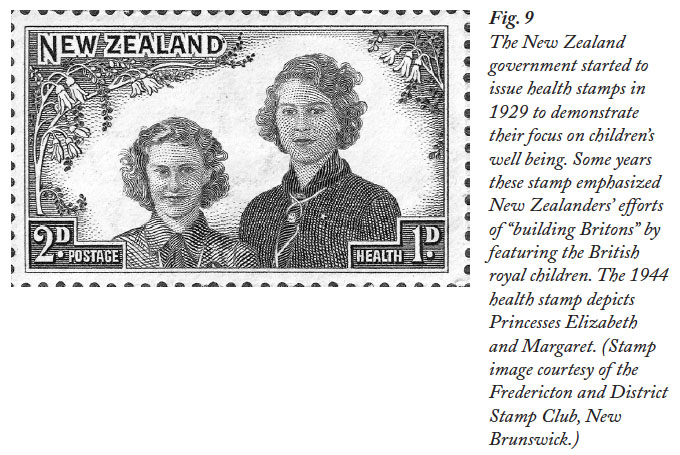 Display large image of Figure 9
Display large image of Figure 922 Between 1855 and the mid-1950s, then, New Zealand stamps consistently reflected and reinforced the country’s close connection to Britain. Between 1957 and 1966, however, New Zealand postage stamps exhibited suggestions that the country’s nationalism was expanding beyond the confines of the British focus to encompass domestic components as well as non-British international perspectives. During that period just 5.7 per cent of New Zealand’s stamps bore the image of the monarch. In its place emerged “national” themes with a civic focus.
23 For example, in 1957 the New Zealand post office issued a set of stamps labelled “Ross Dependency Pictorials” to support New Zealand’s claim of sovereignty over the Dependency (New Zealand Post 1957b). That same year the Post Office began to recognize New Zealand’s own national heroes with a celebration of Dr. Frederic Truby King, a native-born New Zealand medical doctor who had founded the nation’s first hospital dedicated to the care of sick children (New Zealand Post 1957a). Evidence that New Zealand was reaching out to other Pacific nations was evident in 1959 with a stamp that drew attention to that year’s Pan-Pacific Scout Jamboree (New Zealand Post 1959) while the early 1960s witnessed a new and central role for the national flag on New Zealand stamps. Indeed, 1960 marked the first time that the nation’s flag had been portrayed as the exclusive image on a stamp (New Zealand Post 1960). A shift to civic symbolism was readily apparent in 1965 when the annual Commonwealth Parliamentary Association Conference, held in Wellington, generated a three-stamp commemorative series celebrating parliamentary democracy. Only one stamp bore the image of the Queen, and, significantly, the monarch’s black and white image was shared with, and overshadowed by, a slightly larger colour reproduction of the New Zealand Coat of Arms (Fig. 10). The remaining two stamps portrayed a sense of nationalistic pride by showing the City of Wellington and Parliament House (New Zealand Post 1965).
 Display large image of Figure 10
Display large image of Figure 1024 During the last third of the 20th century New Zealand’s postage stamps signalled a pronounced fading of the nation’s British identity with the monarch’s image appearing on just 2.9 per cent of the nation’s stamps and a dramatic expansion of civic-themed images. On July 10, 1967, New Zealand converted from imperial measurement to the decimal system, breaking one of the traditional ties to Britain (Smith 2012: 206). In addition to changing its currency, postage stamps transitioned to decimal denominations. However, unlike the nation’s new decimal banknotes that depicted Queen Elizabeth II, no decimal domestic definitives bearing her image were issued in either 1967 or 1968, the first period in New Zealand history whereby the reigning monarch was not to be found on any domestic definitive stamps (New Zealand Post 1967; Reserve Bank 2013). While 1977 saw a five-stamp commemorative series issued to celebrate Queen Elizabeth II’s Silver Jubilee (New Zealand Post 1977) the overall trend was clear: the British monarch’s once dominant place on New Zealand postage stamps had been usurped. Indeed, when the country issued stamps to celebrate its 150th anniversary in 1990, the Queen was nowhere to be seen (New Zealand Post 1990).
25 The increased focus on civic and domestic symbolism included recognition of women’s roles in New Zealand society. For example, a 1968 stamp depicting a man and a woman registering their vote at a ballot box celebrated the seventy-fifth anniversary of New Zealand’s universal suffrage (New Zealand Post 1968; Smith 2012: 110). The following year, the annual health stamp series featured Dr. Elizabeth Gunn to honour the fiftieth anniversary of her inauguration of the Children’s Health Camp Movement (New Zealand Post 1969). This marked the first time a New Zealand-born female had appeared on a stamp.
26 Throughout this period New Zealand stamps placed greater emphasis on national achievements and characteristics. A 1970 revamping of the definitive pictorials, for example, saw new images added that illustrated New Zealand’s adoption of innovative technology such as geothermal energy production and aerial management of its agricultural crop and livestock resources (New Zealand Post 1970b). In 1988, in preparation for New Zealand’s 1990 sesquicentennial, New Zealand Post initiated a multiyear stamp series entitled “The Heritage Series,” which focused solely on domestic aspects of the country’s traditions including the work of six famous 19th-century New Zealand painters and their portrayals of the nation’s rugged landscape (New Zealand Post 1988). Remarkably, Sir Edmund Hilary, the New Zealand mountaineer who in 1953 was the first man to summit Mount Everest, was not specifically commemorated on a stamp until the 1990s when he was featured in two series, one remembering the prosperous 1950s and another honouring New Zealanders who had accomplished feats of global significance (New Zealand Post 1994, 1999b). In the 1990s, the New Zealand Post issued stamps to remind the world that New Zealand had become the first independent legally nuclear-free country in the world (New Zealand Post 1999b; Smith 2012: 226-32).
27 New Zealand stamps also began to underscore the nation’s growing links with Pacific and Asian nations. Early examples include a three-stamp commemorative series to celebrate New Zealand’s participation in Expo 70 held in Osaka, Japan (New Zealand Post 1970a). In later years, the government signalled its growing acceptance of New Zealanders of Asian descent by issuing stamps bearing the images of animals tied to their ordered appearance in the Chinese Lunar Calendar (New Zealand Post 1997). In 1999, New Zealand Post issued a forty-cent commemorative stamp to celebrate its hosting of the tenth annual meeting of the Asia-Pacific Economic Co-operation (APEC) organization (New Zealand Post 1999a).
28 A key aspect of this growing focus on domestic identity was an emphasis on New Zealand’s ostensible willingness to come to terms with its colonial past. In 1974 Waitangi Day, a day celebrating the February 6, 1840, signing of the Treaty of Waitangi between Māori chiefs and the British, making New Zealand a British colony, was renamed New Zealand Day and made a national holiday. The name change was based on Labour Prime Minister Norman Kirk’s desire to “create a national day distinctive for its remembrance not of a revolution or war, but of a peaceful agreement between two peoples who had grown into a nation of many peoples” (Smith 2012: 237-38). To support this initiative New Zealand postal services released a set of five commemoratives including a stamp showing Pakeha and Māori children learning together in the same classroom (Fig. 11; New Zealand Post 1974). Māori representation on New Zealand stamps increased throughout the 1980s and 1990s with definitive stamps bearing portraits of famous Māori (New Zealand Post 1980) and stamps celebrating the Māori creation story and their famous war dance, the Haka. To celebrate the sesquicentennial of the signing of the Treaty of Waitangi two high-value stamps were issued in 1990 depicting a modern reconstruction of the February 1840 Treaty signing between Māori chiefs and British officials (New Zealand Post 1990).
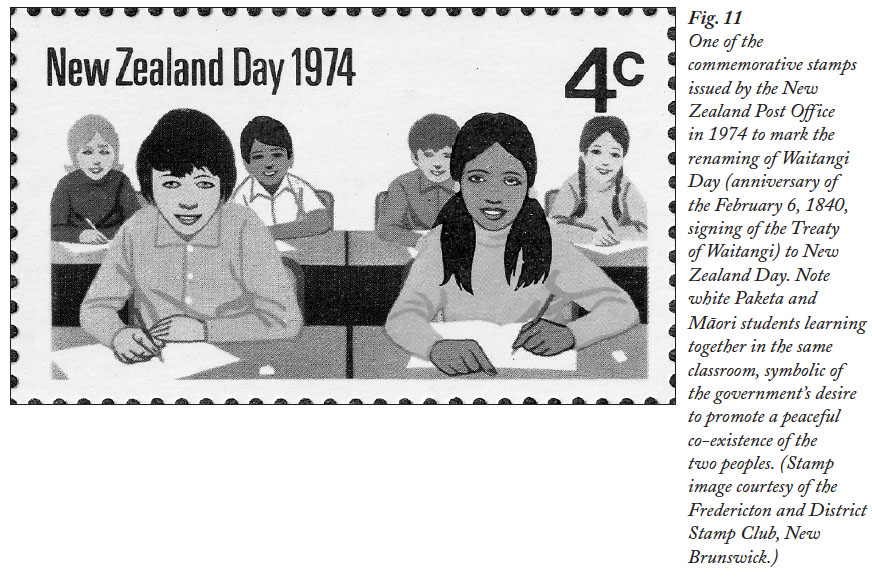 Display large image of Figure 11
Display large image of Figure 1129 In summary, between 1855 and 1999 three distinct eras of New Zealand stamp themes are apparent. From 1855 to 1956, a British focus was engendered by images of the monarch, reminders of British settlement and military support for the Empire. This British flavour declined between 1957 and 1966, with civic nationalistic images such as the nation’s flag, renowned New Zealanders and the nation’s budding diplomatic independence emerging as favoured subjects. For the remainder of the 20th century, nationalistic imagery became the dominant stamp focus, projected by regular appearances of leading male and female Pakeha and Māori citizens with a recurrent highlighting of New Zealand’s autonomy on the world stage and its economic connections to the Asia–Pacific region.
Australia
30 The Commonwealth of Australia was proclaimed on January 1, 1901, but unlike Canada and New Zealand the new government did not issue national postage immediately, relying instead on the earlier stamps issued by individual Australian state governments until 1913. In contrast to New Zealand, where inaugural stamps had a clear British emphasis, the initial theme of Australian stamps was, as noted above, the focus of considerable political debate. Subsequent to this irresolute start, however, Australian postage stamps settled into a balanced pattern of British definitives, symbolized by the British monarch, and civic nationalistic definitives represented by the country’s unique flora and fauna, the latter most commonly represented by the kangaroo, koala, platypus, emu and kookaburra. These definitives were complemented by commemoratives that celebrated Australia’s connections to the British Empire, recognized the achievements of the government and individuals such as explorers instrumental in the development of Australia as well as state anniversaries. The monarch retained a prominent place on Australian stamps until the mid-1960s, appearing on 34 per cent of stamps issued between 1913 and 1964 but just 2 per cent between 1965 and 1999 as Australia embraced civic imagery.
31 The first non-monarchial commemorative stamp, issued in 1927, celebrated the opening of the new Commonwealth Parliament Buildings in Canberra and featured an allegorical “Miss Australia,” interpreted as half-Ceres, half-Britannica (Altman 2010: 55). In 1934, to mark a century of European settlement in Victoria, the government issued a stamp portraying an Australian Aborigine for the first time, a full nineteen years before Canada similarly recognized its Aboriginal heritage in postal images. The Australian Aborigine was depicted as a primitive native with spears in hand, gazing across the Yarra River at a contemporary image of Victoria’s state capital, Melbourne (Altman 1991: 64). It was clear that Aboriginal culture was not being celebrated but rather used as a counterpoint to the advanced culture of the British-settler society. In 1950 Australian stamp history was made when for the first time the portrait of a non-royal living person was depicted. Remarkably, the individual was an Aborigine. The stamp featured the photo of Gwoya Jungarai, commonly known by his nickname as “One Pound Jimmy.”2 This stamp image was repeated in multiple series of definitive stamps up until the time of his death in 1965 (Dodd 2013a: 1950 Issues).
32 Australia’s contribution to the British Empire’s Great War efforts was remembered in 1935, in conjunction with the twentieth anniversary of the landing of Australian (and New Zealand) troops on the shores of Gallipoli in 1915. The 1935 ANZAC (Australian and New Zealand Army Corps) commemoration stamp did not depict the iconic Australian Diggers that graced Australian war memorials but rather the British Empire’s Cenotaph in London (Fig. 12). This stamp design, suggested by the Australian Returned Soldiers League, confirmed the sentiment that Australian service men thought of themselves primarily as members of the British Empire as opposed to Australian citizens (Dodd 2013a: 1935 Issues; McQueen 1987: 13). In 1955 the Postmaster General issued a stamp celebrating the friendship, which existed between Australia, and the United States in particular highlighting the latter’s Pacific role during the Second World War. It is significant that Australia is represented on the stamp, not by a nationalistic symbol, but by Queen Elizabeth II looking at a reproduction of the Australian-American Memorial in Canberra (Dodd 2013a: 1955 Issues).
 Display large image of Figure 12
Display large image of Figure 1233 As in Canada and New Zealand, Australian postage stamps underwent significant changes in the mid-1960s, in particular a significantly reduced frequency with which they portrayed connections to the British Empire. For example, the 1965 ANZAC commemorative stamp issued to remember the fiftieth anniversary of Gallipoli was much different than that issued for the twentieth anniversary. The 1965 image featured an image of Simpson and his donkey, Simpson being the Australian ambulance medic at Gallipoli who transported wounded soldiers to medical stations on the back of his donkey (Fig. 13). Having been killed by shrapnel in the course of his duties, Simpson came to symbolize for Australians the selfless heroism of the Australian Digger at Gallipoli (Walsh 1983).
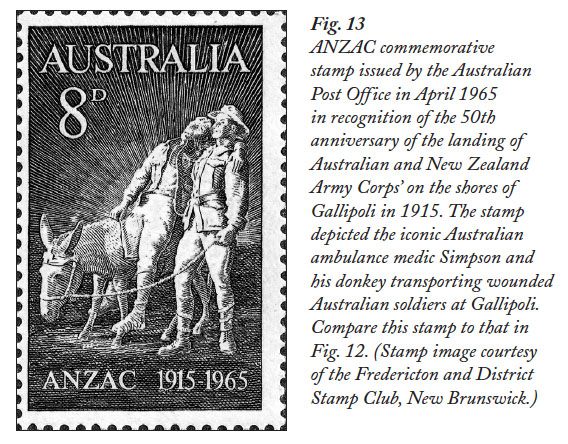 Display large image of Figure 13
Display large image of Figure 1334 A more forceful indication of Australia’s declining British connection was the decision, taken in the early 1970s, to no longer issue definitives bearing the monarch’s image on the grounds that the government wished to have the nation’s stamps feature “subjects of wide popular appeal” (Robinson 1976). This preference for postal images other than the Queen was borne out in a 1975 survey by Australia Post that determined that only 4 per cent of Australians wanted to see the monarch on their stamps, with the majority preferring images of Australian flora, fauna, scenes and historical events (The not so royal mail 1978). The government continued to issue commemorative stamps featuring the Queen (Dodd 2013c).
35 Looking inward during the late 1960s to broaden the basis of the new civic nationalism, the government issued stamps that celebrated famous Australian men and women. In 1968, the Postmaster General issued for the first time a series of stamps entitled “Famous Australians” which embraced such notables as poet Andrew Barton “Banjo” Paterson, pioneer social worker Caroline Chisholm and noted Aboriginal artist Albert Namatjira (Dodd 2013a: 1968 Issues). This series initiated a pattern of release honouring men, women and Aboriginals that continues to the present day. Male figures dominated early on but a 1975 series focused solely on women and featured female writers, suffragettes, parliamentarians and Truganini, the 19th-century princess often considered erroneously by some to be the last Tasmanian Aborigine (Dodd 2013a: 1975 Issues; Vellutini 2003: 127-33). Later stamps included deceased Australian Prime Ministers (Dodd 2013b).
36 As James Curran and Stuart Ward point out, Australians have struggled to define the components of their new nationalism. This struggle was apparent in their postal images, in particular the Australia Day and Bicentennial series of stamps. In 1978, Australia Post initiated the tradition of annually issuing stamps to bolster the celebration of Australia Day with some years showcasing the National Flag in a number of innovative ways, complemented in other years by images celebrating the heritage of Australia as an English-settler colony (Dodd 2013a: 1978 Issues). However, on some occasions themes were interjected to try to bring awareness to other components of Australia’s emerging national identity. For example, the 1982 Australia Day stamp drew attention to the immigrant and multicultural heritage of Australia by illustrating the three great waves of immigration that had characterized the country’s settlement history. On the single stamp, which anticipated the Living Together theme of the 1988 Bicentennial celebrations, an Aborigine represents immigrants arriving during the Dream Time, an Anglo-Saxon depicts the 1788 colonists and a non-Anglo-Saxon represents post–Second World War immigrants (Fig. 14; Dodd 2013a: 1982 Issues; Cochrane and Goodman 1988: 31). Australian Aboriginal art appeared on Australia Day stamps in 1986 and 1993 in keeping with the International Year of Indigenous peoples. The 1986 stamp depicted the nation being cradled and protected by a Wandjina, an Australian Aboriginal spirit (Dodd 2013a: 1986 Issues, 1993 Issues).
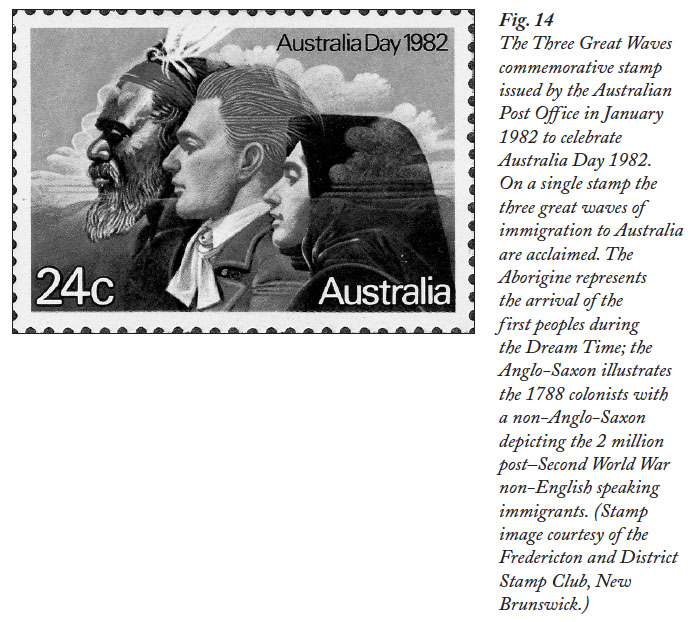 Display large image of Figure 14
Display large image of Figure 1437 The 1988 Australian Bicentenary celebrations were characterized by a lively debate between the Labour Party, who favoured a “Living Together” theme, and the Liberals, who desired an “Australian Achievement” focus. As Curran and Ward explain, the “Living Together” theme would highlight relationships “between black and white Australians, between one ethnic group and another, between city and country, between man and his environment, between Australia and our neighbours, particularly the developing countries of South-East Asia.” The “Australian Achievement” theme, in contrast, was designed to celebrate “positive achievements and triumphs over adversity and social problems” (Curran and Ward 2010: 231-37).
38 This dual emphasis produced conflicting themes at the 1988 Australian Bicentennial Exhibition (Cochrane and Goodman 1988: 33). Australia Post appears to have adopted a similar approach and issued a flurry of bicentennial stamps that on the one hand paid tribute to Australian Aborigines but on the other hand saluted the achievements of European explorers (Dodd 2013a: 1984, 1985, 1986, 1987, 1988 Issues). A final 1988 series, although not assigned a “bicentennial” label by Australia Post, actively embraced a more inclusive ideal of Australian citizenship. These “Living Together” definitives depicted all classes of Australians living and working together in a diverse variety of occupations and services and celebrated Australians overcoming race, class and gender divisions to work together (Fig. 15; Dodd 2013a: 1988 Issues).
 Display large image of Figure 15
Display large image of Figure 1539 During the 1980s and 1990s Australian stamps served to underscore the country’s efforts to reshape its international relationships. In 1988, for example, Australia produced three joint issues with the U.S., the U.K. and New Zealand to highlight its close relationship with those nations (Dodd 2013a: 1988 Issues). In 1990 Australia Post issued its first joint postage stamp series with the USSR (Dodd 2013a: 1990 Issues). Joint stamps issued with Thailand and Laos (1994), China (1995) and Indonesia (1996) illustrated that, like New Zealand, Australia was keen to integrate itself economically and politically into the Asia–Pacific region (Dodd 2013a: 1994, 1995, 1996 Issues).
40 Twentieth-century Australian stamp imagery reflects two distinct thematic periods: a pre-1960s phase that demonstrated a tension between British and Australian nationalistic images and a post-1960s chapter in which postal designs helped define the nation’s new civic nationalism. Representations of the monarch and the nation’s preference for white immigrants on the earliest postage stamps reinforced Australia’s close connection to the British Empire. This Anglo-Saxon refrain was complimented by imagery celebrating the uniqueness of the nation’s flora and fauna—in particular the kangaroo. However, post-1960s stamps reinforced the new nationalistic spirit with the elimination of the monarch on defini- tives in favour of regular appearances of the flag, and Australian men, women and Aborigines who had been instrumental in the development of the country. The emergence of a national identity, broader than its once-constrained British theme, was confirmed in the 1990s by Australia’s joint-issue stamp releases with regional and global partner nations.
Comparisons and Conclusions
41 Prior to the middle of the 20th century, postage stamps in all three dominions prominently championed a British national identity, although representations of other nationalistic themes were also visible during this period. The images on Canadian and New Zealand postage stamps, prior to 1898, were solely of the British sovereign, thus emphasizing Anglo-settler connections to the British Empire. Monarchial definitives trumpeted the pro-British allegiances of both countries during the first half of the 20th century. However, starting in 1898 New Zealand broadened this British theme by adding definitive stamps that promoted its Arcadian myth and championed the health of its children. Canada also augmented its British definitive stamp focus by issuing commemorative stamps in 1908 that included a French theme and by making stamps bilingual in 1927. On the other hand, Australia’s postage stamps from their origins in 1913 reflected the debate between Australians who preferred to have their country’s stamps reflect an unmistaken British imperial identity and those who favoured a more nationalistic theme, albeit of an Anglo-Saxon character. In the end Australian stamps depicted both themes simultaneously, but to further complicate the tension between the British and the nationalistic proponents, Australia in 1950 was the first of the dominions to place the image of a living Aborigine on a stamp. Still, each of the three dominions reinforced their British-national identity by releasing stamps that celebrated their nation’s military support of the British Empire during the pre-1950s period.
42 The decline of British postal imagery appeared first on Canadian stamps. As José Igartua demonstrates, the late 1950s was a period when the staunch British identity of English-speaking Canadians was starting to soften (2006: 89-114). Canada’s postage stamps also exhibited a downplaying of the nation’s ethnic identity through a gradual introduction, starting in the early 1950s, of civic symbols such as indigenous wildlife alongside traditional ethnic representations. Stamps of the late 1950s promoted cooperation between Canada’s two dominant peoples as well as other groups. Additionally, Canada’s desire to be involved internationally beyond the British Empire was publicized by commemorative stamp images marking joint undertakings with the U.S., NATO and the United Nations. Additionally stamp imagery that included Aboriginal culture and women pointed to a Canadian national identity that was becoming broader and more inclusive.
43 New Zealand postage stamps showed evidence of an evolving national identity in the late 1950s and early 1960s, slightly later than Canada, through a decline in the prominence of the monarch. Moreover, the celebration of domestic and international achievements highlighted the emergence of an independent nationalism. Changes in Australian postal imagery came later, in the early 1960s, but once implemented the progression was more rapid and dramatic than in either Canada or New Zealand. For example, Australia permanently dropped monarchial definitives in the early 1970s with the Queen’s image only appearing on commemorative stamps while Canada and New Zealand never completely abandoned the tradition of issuing monarchial definitives. Both Australia and New Zealand converted to decimal postage denominations in 1966 and 1967 respectively, which ushered in a further shift away from British postal imagery.
44 Although ethnic representations on national postage never completely disappeared in any of the three dominions, during the last third of the 20th century they were unquestionably overwhelmed by a plethora of nationalistic civic images. In Canada the monarch lost sole billing on stamps with the simultaneous inclusion of Canadian economic and geographic symbols on the same stamp faces. Eventually in 1990 the Canadian Flag became the permanent national symbol on Canadian regular postage. Stamps pointed to the evolution of the Canadian identity by marking the independence of Canada’s constitution, while celebrating Aboriginal heritage, Canadian arts and culture along with the multicultural, human rights–based nature of the nation’s society. In New Zealand postal images depicted a national identity that was more inclusive of Māori and women and advertised to the world the fact that the nation was willing to break with such allies as the United States over nuclear policy, and was comfortable embracing its Asia–Pacific neighbours. Australia used postage stamps to acknowledge its Aboriginal peoples and the liberalization of its immigration policy. Additionally, Australian stamps, like those of New Zealand, exhibited the nation’s desire to partner with the Asian international community. Canada and Australia also demonstrated their close ties with the United States. Each nation released joint-issue stamps with the U.S., celebrating bi-national accomplishments such as the St. Lawrence Seaway or, in the instance of Australia, its bicentennial celebrations. All three dominion governments appreciated the value of using their nation’s flag as the sole motif on a stamp face, to promote civic nationalism. New Zealand led in 1960, Canada followed in 1965, to celebrate the nation’s new banner, and Australia followed in 1978, to kick off an enhanced awareness of Australia Day.
45 Overall, the governments of all three dominions used postage stamps as instruments to help crystallize evolving public sentiments regarding national identity. In doing so they sought to ensure that national identity in each of these countries evolved from an ethnic characterization, generated from a European-resettlement origin, to a civic-based nationalism. Moreover, an examination of postage stamp images confirms that the redefinition of national identity was initiated in all three dominions during the middle decades of the 20th century closely paralleling the rise of French Canadian nationalism in Canada and Britain’s turn toward Europe, and away from its southern hemisphere dominions, for long-term security. More importantly, from a comparative perspective, postage stamps reveal that the new non-ethic national identities in each of the dominions were remarkably similar in that they projected a significant theme of civic nationalism. They were also more inclusive of their respective Aboriginal populations, endeavoured to recognize the contributions of both genders, immigrants and different classes in the development of their nations, while simultaneously embracing international involvement.
46 The progression of images in all three countries illustrates that their governments recognized the value of postage stamps as instruments of change to assist with the redefinition of their respective national identities. Furthermore, the relatively frequent amending of stamp imagery demonstrates that these governments noted the ease of using postage stamps to redefine national identity as compared to other symbols of nationalism such as the flag, national anthem or currency images, which in comparison remained relatively static over the same time period. Governments did on occasion, through competitions, encourage citizens to put forward ideas for stamp imagery that represented what citizens wanted to see for postal images.
47 However, given the governmental monopoly on the approval of postal imagery, one must understand that the character of the national identity, as presented by postal images, represents what the political establishment approved (Jones 2001: 405). Consequently, stamps provide a window into official culture as understood by governments, rather than always reflecting the vernacular culture originating from individual citizens or groups. However, despite this limitation, postage stamps offer a useful tool for broad comparative studies of postcolonial developments as well as a number of related fields. As David Scott reminds us, postage stamps are a site of cultural memory for a nation (Scott 2002: 107). In particular, they demonstrate a government’s awareness of “others” such as Aboriginal groups, minorities, immigrants as well as women, making them useful for historians interested in the societal recognition of marginal groups in postcolonial settings. More broadly, the examples detailed above should encourage scholars, particularly those interested in comparative and postcolonial history, to embrace Raento’s and Brunn’s observations that stamps are a component of “banal nationalism” and have been used by governments to construct an endemic national identity.
48 In spite of the 21st-century explosion of electronic communication methods such as emailing, texting and social networking, government postal authorities in these three dominions continue to use postage stamps, in the words of Paul Van der Grijp, to bring disparate parts of their nation together (2004: 87). One need only observe the plethora of images on current Canadian, New Zealand and Australian stamps that celebrate national abilities in sports, both at national and Olympic levels, icons of pop culture, as well as domestic accomplishments to realize stamps still play an active role in building national identity in these dominions in the third millennium.
I would like to thank Dr. Michael Dawson of the History Department at St. Thomas University for his inspiration and editorial advice as well as my wife Gail and two daughters Martha and Clare for their continued encouragement.